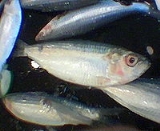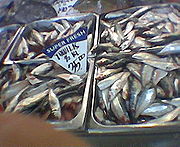
Sardinella tawilis
Encyclopedia
Sardinella tawilis is a freshwater sardine found exclusively in the Philippines. It is unique in that it is the only member of the family Clupeidae
that is known to exist entirely in freshwater. Locally, they are known in Filipino
as tawilis.
in Batangas
province
on the island of Luzon
in the Philippines. The third largest lake in the Philippines
used to be the caldera of an ancient volcano. Before recent history, the lake was but an extension of the entirely-marine Balayan Bay. Major eruptions in the 18th century essentially sealed the lake from the sea, eventually leading its waters to become non-saline. Sardinella tawilis is believed to be one of a few formerly-marine species trapped within the lake that have evolved into purely freshwater species.
S. tawilis prefer to ingest larger prey, such as adult copepod
s, supplemented with rotifer
s and water fleas. It has been found that during the summer months when the density of smaller copepods were much higher, S. tawilis stomach contents consisted primarily of calanoid copepods, which are larger than the copepods blooming during this time. This suggests some partial control over prey selection exhibited by the fish, as opposed to simple filter-feeding.
Little is known about their reproduction. It is known that the Taal population spawns during the months of April to July, when surface temperatures are highest.
The species was originally identified and named in 1927 as Harengula tawilis by Albert William Herre
, the Chief of the Fisheries Division of the Bureau of Science in Manila. The species was later moved to the more appropriate and taxonomically accurate genus, Sardinella
.
 Despite its threatened status, tawilis stocks in Lake Taal have been commercially fished for several decades. The fish is a widely-popular food fish in the Philippines, and tons are shipped to most of the major cities in the country. Local supermarkets and wet markets usually have a tray or pile dedicated solely to the species.
Despite its threatened status, tawilis stocks in Lake Taal have been commercially fished for several decades. The fish is a widely-popular food fish in the Philippines, and tons are shipped to most of the major cities in the country. Local supermarkets and wet markets usually have a tray or pile dedicated solely to the species.
The species is commonly referred to as "tawilis" in the local language of Tagalog
. On the island of Cebu
, one of the many places where tawilis is shipped, the native Cebuano
name for the fish is "tunsoy".
In addition to raw consumption, tawilis are also processed into various food products. Tawilis is one of the many fish species dried, salted and sold as "daing" in the country. They are also smoked and bottled in oil, and sold commercially.
Clupeidae
Clupeidae is the family of the herrings, shads, sardines, hilsa and menhadens. It includes many of the most important food fishes in the world.-Description and biology:...
that is known to exist entirely in freshwater. Locally, they are known in Filipino
Filipino language
This move has drawn much criticism from other regional groups.In 1987, a new constitution introduced many provisions for the language.Article XIV, Section 6, omits any mention of Tagalog as the basis for Filipino, and states that:...
as tawilis.
Anatomy and Morphology
S. tawilis are small fish reaching up to 15 cm and weighing less than 30 g. Like other members of their family, they have laterally compressed bodies with bellies covered in tough scale-like scutes. They have a single, triangular dorsal fin and a forked caudal fin. They possess long, slender gill rakers in their mouths.Range and Distribution
Tawilis populations are found only in a Taal LakeTaal Lake
Taal Lake is a freshwater lake in the province of Batangas, on the island of Luzon, Philippines. The lake is situated within a caldera formed by very large eruptions between 500,000 and 100,000 years ago. It is the country's third largest lake...
in Batangas
Batangas
Batangas is a first class province of the Philippines located on the southwestern part of Luzon in the CALABARZON region. Its capital is Batangas City and it is bordered by the provinces of Cavite and Laguna to the north and Quezon to the east. Across the Verde Island Passages to the south is the...
province
Provinces of the Philippines
The Provinces of the Philippines are the primary political and administrative divisions of the Philippines. There are 80 provinces at present, further subdivided into component cities and municipalities. The National Capital Region, as well as independent cities, are autonomous from any provincial...
on the island of Luzon
Luzon
Luzon is the largest island in the Philippines. It is located in the northernmost region of the archipelago, and is also the name for one of the three primary island groups in the country centered on the Island of Luzon...
in the Philippines. The third largest lake in the Philippines
Philippines
The Philippines , officially known as the Republic of the Philippines , is a country in Southeast Asia in the western Pacific Ocean. To its north across the Luzon Strait lies Taiwan. West across the South China Sea sits Vietnam...
used to be the caldera of an ancient volcano. Before recent history, the lake was but an extension of the entirely-marine Balayan Bay. Major eruptions in the 18th century essentially sealed the lake from the sea, eventually leading its waters to become non-saline. Sardinella tawilis is believed to be one of a few formerly-marine species trapped within the lake that have evolved into purely freshwater species.
Ecology
S. tawilis, like members of its family, are epipelagic filter feeders, using their gill rakers to strain plankton from the water while they swim with their mouths open. They roam the lake in large schools, just below the surface as the volcanic (and thus sedimentary) nature of the lake limits their plankton food to the surface.S. tawilis prefer to ingest larger prey, such as adult copepod
Copepod
Copepods are a group of small crustaceans found in the sea and nearly every freshwater habitat. Some species are planktonic , some are benthic , and some continental species may live in limno-terrestrial habitats and other wet terrestrial places, such as swamps, under leaf fall in wet forests,...
s, supplemented with rotifer
Rotifer
The rotifers make up a phylum of microscopic and near-microscopic pseudocoelomate animals. They were first described by Rev. John Harris in 1696, and other forms were described by Anton van Leeuwenhoek in 1703...
s and water fleas. It has been found that during the summer months when the density of smaller copepods were much higher, S. tawilis stomach contents consisted primarily of calanoid copepods, which are larger than the copepods blooming during this time. This suggests some partial control over prey selection exhibited by the fish, as opposed to simple filter-feeding.
Little is known about their reproduction. It is known that the Taal population spawns during the months of April to July, when surface temperatures are highest.
Etymology and Taxonomic History
Sardinella is straightforwardly derived from the Greek "sarda", literally "sardine".The species was originally identified and named in 1927 as Harengula tawilis by Albert William Herre
Albert William Herre
Albert William Christian Theodore Herre was an American ichthyologist and lichenologist.Herre was born in 1868 in Toledo, Ohio....
, the Chief of the Fisheries Division of the Bureau of Science in Manila. The species was later moved to the more appropriate and taxonomically accurate genus, Sardinella
Sardinella
SardinellaSardinella is a genus of fishes in the family Clupeidae. This genus currently contains 21 recognized species. These fish are generally coastal, schooling fish, and abundant in warmer waters. They can be found nearly anywhere in the tropic and subtropic oceans of the World...
.
Importance to Humans

The species is commonly referred to as "tawilis" in the local language of Tagalog
Tagalog language
Tagalog is an Austronesian language spoken as a first language by a third of the population of the Philippines and as a second language by most of the rest. It is the first language of the Philippine region IV and of Metro Manila...
. On the island of Cebu
Cebu
Cebu is a province in the Philippines, consisting of Cebu Island and 167 surrounding islands. It is located to the east of Negros, to the west of Leyte and Bohol islands...
, one of the many places where tawilis is shipped, the native Cebuano
Cebuano language
Cebuano, referred to by most of its speakers as Bisaya , is an Austronesian language spoken in the Philippines by about 20 million people mostly in the Central Visayas. It is the most widely spoken of the languages within the so-named Bisayan subgroup and is closely related to other Filipino...
name for the fish is "tunsoy".
In addition to raw consumption, tawilis are also processed into various food products. Tawilis is one of the many fish species dried, salted and sold as "daing" in the country. They are also smoked and bottled in oil, and sold commercially.
Conservation
Because of several factors, the species is threatened by overfishing. As with all species consisting of a single population in one location, a local extinction event will most probably lead to species extinction. As the population of the Philippines grows, there will be greater demand for tawilis, possibly overfishing the lake's stock population.External links
- "Born to be Wild: Tawilis" on GMA News Online (2008_0313)

